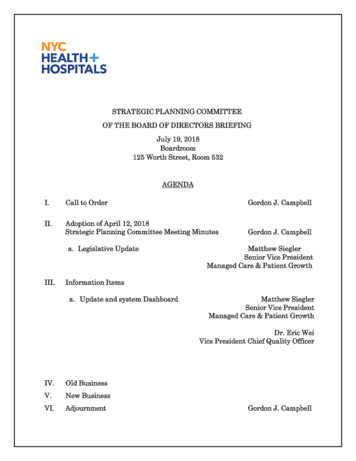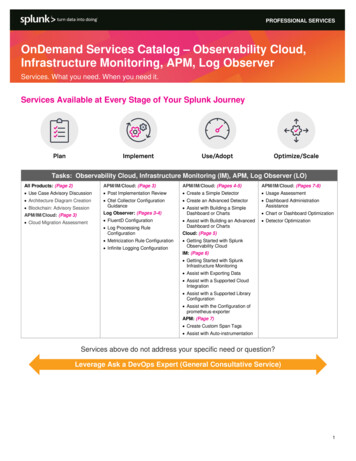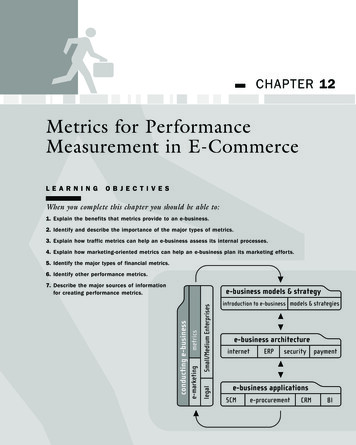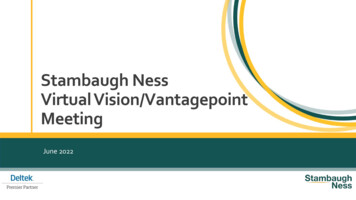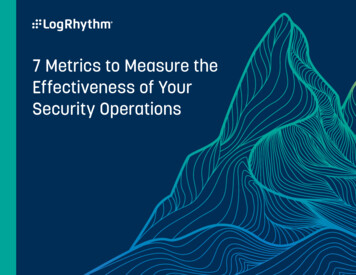
Transcription
7 Metrics to Measure theEffectiveness of YourSecurity Operations1
IntroductionYou can’t improve what you don’t measure. To mature your security operationscenter (SOC) and security operations program, you need to evaluate itseffectiveness. But measuring your security operations program effectivenessisn’t an easy task.If showing the effectiveness of your security operations (SecOps) is a challenge,it might be time to re-evaluate your KPIs and your ability to measure them.This e-Book is designed to help you understand the keyoperational metrics you should measure and communicate your SecOps effectiveness to detect and respondto cyber-related events.2
Why Measure Your SecurityOperations Effectiveness?If you apply security metrics to your security program, you willenable your organization to make wiser decisions and demonstratevalue to the board and other stakeholders.The problem is that the most companies aren’t far along in their security maturity. In a surveyof more than 250 security operations practitioners, one in five respondents claimed theyhad mature security operations.1 The remaining 80 percent said they were just starting theirWhere do youstand with your securityoperations capabilities?It’s can be difficult to know the stateof your security operations withouthaving measurable goals. If you startby reducing your dwell time of acyberthreat, you may very wellsave the day.journey or were only halfway through it.2A 2020 Mandiant report indicated thatthe median amount of time an attackerwas present in a victim’s network was56 DAYSbefore being detected. 3This represents a28%DECREASEin dwell time from 2018.4The Road to Security Operations Maturity: A Cyentia Institute Research Report, Siemplify, June 2019IBID3M-Trends 2020, FireEye Mandiant Services Special Report, FireEye, Feb. 20, 20204IBIDWhile dwell time measurementsimproved, you still must bevigilant with your cybersecurityand security maturity efforts.123
Improve Your Team’s EffectivenessHow do you get started? If you aren’t already, the first set ofMeanwhile, MTTR helps you measure the time it takes to remediatemetrics you should be tracking is mean time to detect (MTTD) andand respond to a threat. The higher your response time, the greatermean time to respond (MTTR). These are the critical indicators ofyour chances are for a costly breach or damage. As with MTTD, theyour operational effectiveness. These metrics support the successgoals are to reduce your response time and lower your risk.of your security operations program.While MTTD and MTTR are important metrics to measure to baselineReducing MTTD and MTTR is the primary goal of a resilient securityyour team’s capabilities, it’s crucial to track the effectiveness of youroperations program. MTTD allows you to track the time it takes toteam as your organization’s maturity increases.discover a possible threat. This metric helps you understand theeffectiveness of your organization’s security tools and your team’sspeed to detect a threat. The goal is to keep this metric as low aspossible to minimize the impact on your organization.Like any core business operation, if you’re interested in maturingyour organization, you should measure operational effectiveness toidentify whether your organization is realizing its KPIs and SLAs.Figure 1: By understanding your MTTD and MTTR, you can lower your risk to cyberthreats and improve your security effectiveness4
7 Key Metrics for SecurityOperations SuccessBeyond MTTD and MTTR, there are other metrics you should track to ensure that you’re effectivelycommunicating organizational and operational effectiveness to cyberthreats. This e-Book suggestsseven metrics you should measure that can help you visualize improvements to your securityoperations program.TTTTTQTTITTMTTVTTQTTR5
TTTTTQ1. Alarm Time to Triage2. A larm Time to QualifyAlarm Time to Triage (TTT) measures latency in the team’s abilityAlarm Time to Qualify (TTQ) measures the amount of time itto immediately inspect an alarm. It helps you understand the levelof real-time responsiveness to threats.This metric: Measures within alarm priority bands (e.g., high/medium/low,risk score bands, etc.) Might indicate the team can take on additional monitoringload (e.g., monitoring another area of the IT infrastructure) Might indicate a need for increased staff, or for the team tonarrow its monitoring focus (e.g., focusing only on highestrisk areas of the IT infrastructure and ignoring others)Alarm Time to Triage (TTT) Date/Time Alarm Inspection - Date/Time ofAlarm Creationtook an alarm to be fully inspected and qualified. TTQ helps youidentify bottlenecks and understand your team’s capacity forqualifying threats.This metric: Should be measurable/reportable within alarm priority bands(e.g., high/medium/low, risk score bands, etc.) Should be measurable/reportable within alarm outcome(e.g., false positive, benign issue, incident, etc.) Might indicate weakness in the technological securityoperations solution in the area of alarm drill down, search,data analysis, and contextual analysisAlarm Time to Qualify (TTQ) Date/Time of Alarm Closure or Addition to Case Date/Time of Alarm Creation6
TTITTM3. Threat Time to Investigate 4. Time to MitigateThreat Time to Investigate (TTI) measures the amount of timeTime to Mitigate (TTM) measures the amount of time it tookit took to fully investigate a qualified threat. It helps youidentify bottlenecks and understand the team’s capacity forto mitigate an incident and remove the immediate risk to thebusiness. TTM helps you understand how quickly your team caninvestigating threats.mitigate the issue to stop or slow down an active threat.This metric:This metric: Should be measurable/reportable based on threat/incidenttypes (e.g., via the MITRE ATT&CK categories) Should be measurable/reportable based on threat/incidenttypes (e.g., via the MITRE ATT&CK categories) Might indicate slowness in the technology securityoperations solution in the area of search, data analysis,contextual analysis, and collaboration Might indicate slowness in the technology solution in thearea of evidence capture and use, standard playbooks,automation, and collaborationThreat Time to Investigate (TTI) Date/Time of Case Closed or Elevated to Incident Date/Time of Case CreationTime to Mitigate (TTM) Date/Time Incident Mitigated - Date/TimeIncident DeterminationMITRE ATT&CK is a globally-accessible knowledge base of adversary tactics andtechniques based on real-world observations. ATT&CK is used as a framework tohelp organizations develop specific threat models and methodologies in the privatesector, in government, and in the cybersecurity product and service community.Source: MITRE ATT&CK, The MITRE Corporation, 20207
TTVTTM5. Time to Recover6. Incident Time to DetectTime to Recover (TTV) measures the amount of time it tookIncident Time to Detect (TTD) measures the amount of timeto recover fully from an incident. Measuring TTV helps youunderstand how quickly your security team and other involvedgroups can completely recover from an incident. It can identifyit took to confirm an incident was initially detected andultimately qualified. TTD is a key measure of security operationseffectiveness that shows the amount of time it took to identifyoperational and collaboration bottlenecks.threats that actually resulted in an incident.This metric:This metric: Should be measurable/reportable based on threat/incidenttypes (e.g., via the MITRE ATT&CK categories) Should be measurable/reportable based on threat/incidenttypes (e.g., via the MITRE ATT&CK categories) Might indicate slowness/weakness in the technology securityoperations solution in evidence capture and use, standardplaybooks, automation, and collaboration Should be measurable/reportable based on threat detectionmethod (e.g., hunting, behavioral analytics, scenarioanalytics, specific threat detection technology, etc.) Might indicate slowness/weakness in the technology solutionin the areas supporting threat discovery (e.g., threat hunting,behavioral anomaly detection) and workflow capabilitiessupporting threat qualification (e.g., search, data analysis)Time to Recover (TTV) Date/Time of Recovery from Incident - Date/Time ofIncident MitigationIncident Time to Mitigate (TTD) Date/Time Threat Qualified for Investigation/CaseCreation - Date/Time of Initial Indicator of Threat8
TTR7. Incident Time to ResponseIncident Time to Response (TTR) measures the amount of timeit took to investigate and mitigate a confirmed incident. TTR is akey measure of security operations effectiveness that shows theamount of time it took to analyze and mitigate threats that actuallyresulted in an incident.This metric: Should be measurable/reportable based on threat/incidenttypes (e.g., via the MITRE ATT&CK categories) Might indicate slowness/weakness in the technology solutionin the areas supporting threat investigation (e.g., search) andmitigation (e.g., automation)Incident Time to Recover (TTR) Date/Time of Incident Mitigation - Date/Time Initiatedof Investigation9
ConclusionTo show the value of your security program, you need to set a baseline and then track yourprogress in improving your efficiency over time. That’s where measurement comes in. Thefirst step is to determine which metrics you should track and measure. As your organizationmatures, metrics will help you better understand how your security operations programis performing and where you can improve. Metrics can also help you prove the program’svalue to the board.With LogRhythm, measuring the effectiveness of your SOC is easy.Our embedded SOC metrics can help your team uncover opportunitiesto improve operational efficiency, including identifying tasks bettersuited for automation, and enable you to measure and report on theeffectiveness of your security program.Want to see LogRhythm in action?Schedule a demo today10
About LogRhythmLogRhythm empowers more than 4,000 customers across theglobe to measurably mature their security operations program.LogRhythm’s award-winning NextGen SIEM Platform deliverscomprehensive security analytics; user and entity behavior analytics(UEBA); network detection and response (NDR); and securityorchestration, automation, and response (SOAR) within a single,integrated platform for rapid detection, response, and neutralizationof threats.Built by security professionals for security professionals,LogRhythm enables security professionals at leading organizationslike Cargill, NASA, and XcelEnergy to promote visibility for theircybersecurity program and reduce risk to their organization eachand every day. LogRhythm is the only provider to earn the GartnerPeer Insights’ Customer Choice for SIEM designation three years in arow. To learn more, please visit logrhythm.com.11
1.866.384.0713 // info@logrhythm.com // 4780 Pearl East Circle, Boulder CO, 8030112
analytics, specific threat detection technology, etc.) Might indicate slowness/weakness in the technology solution in the areas supporting threat discovery (e.g., threat hunting, behavioral anomaly detection) and workflow capabilities supporting threat qualification (e.g., search, data analysis) Time to Recover (TTV)








